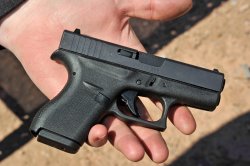With this article we'll try to shed some light in this vaste and dark land, at least in regards to the materials used in handgun manufacture, of which there’s indeed considerable variety: plastic or metal? And then, alloy or steel? And, again, investment cast or forged? Choices… choices…

Some models can be had in “any color, so long as it’s black” as Henry Ford used to say. You want a Glock? Then, it’s going to be plastic for you. But some guns may be available in a vast choice of materials. The venerable 1911 comes instantly to mind, but also the countless numbers of CZ-75 clones and a many others.
What’s the real difference?

Well, plastic is light and tough, but no matter how efficient and effective it is, undoubtedly its lackluster look can’t hold a candle to a well polished, blued steel gun. So, if aesthetics come into play, metal has certainly its own virtues.
Not to mention the fact that light weight is not always a virtue: a steel gun may be less comfortable to carry, but is undoubtedly a more stable shooting platform.

Here you enter a scene were personal opinions vary greatly and are fought upon with religious vehemence. Some swear by forged steel and wouldn’t touch anything else. Others praise the merits of investment cast steel or Aluminum alloys. The truth, as always, doesn’t lie in a single answer.
First of all, let’s debunk the myth of “steel quality”. Most steels used for gun manufacturing are medium grade steels that can’t stand comparison, from a purely metallurgical point of view, with steels used for example in knife manufacturing (all the more so if we are talking about custom knives). Is this relevant?

No, sorry but the truth is that it’s not: any manufacturing process has its own peculiarities and different manufacts have their own set of requirements, and it’s pointless to use an expensive material when a cheaper one fits the bill equally well: some of the first magazines in the earliest semiauto pistols were milled out of solid steel stock.

As quaint and fascinating this may indeed look, the (perhaps unglamorous) truth is that this happened for lack of technical know-how in sheet metal working processes and since it’s become available, stamped steel has worked equally well at a hundredth of the cost, though for sure a stamped steel magazine isn’t as awe inspiring to the collector; and even if it’s certainly possible to make a gun out of space-age technology powder wondersteels, with their superfine and homogeneous grain, or even hand forged damascus (it’s been done), this doesn’t add a thing to the strictly functional properties of the finished gun, and everyday run-of-the-mill 410 series stainless works just as fine with still strength to spare and at a fraction of the price.

Forging has been for decades the best manufacturing process because of what steels allowed at the turn of the XX century, but with progress in metallurgy and microfusion technologies in the last thirty years, applied to specifically designed alloys, we can now build microfused gun frames that have nothing to envy to their forged counterparts.

Cz-75 frames are microfused, and the gun has a stellar reputation for accuracy, durability and reliability. The Ruger Super Redhawk has been designed with heavy hunting and silhouette shooting with a steady diet of hot loads in mind, while the Super Blackhawk revolvers are used for many custom works chambered for some of the most extreme wildcats like the .480 Ruger or the Linebaugh cartridges: both have a microfused frame. So the process by itself today is not indicative of the final mechanical properties of the manufact: how it is implemented is far more important than the method in itself.

Is therefore a forged gun just fancy? No, it does have superior mechanical properties. But this does not necessarily means another product will not work just as well.
Be it plastic, aluminum alloys, microfused or forged steel, what’s the best choice depends on our requirements, our sense of aestetics and, more often than not the most relevant parameter, our budget. A 10€ Swatch will show you the time just as well as a 10.000€ Breguet and, from a purely functional point of view, a well made 500€ plastic framed handgun will shoot just as well and reliably as a 5000€ top notch forged steel, exotic wood gripped, gold inlaid custom handgun.
So is the latter worth the additional expense? The answer lies in each of us, and is not the same for everybody. If all we are interested in is reliability and toughness at a great price for defense purposes or plinking, than the plastic gun is surely the best choice. If we are interested in mechanical finesse and sophistication that make a collectible out of a lump of steel, then probably a rust-blued vintage Mauser C96 that nobody in his right mind would today carry as a personal defense implement is what best fits your needs, with all in-the-middle cases laying between these two extremes.











